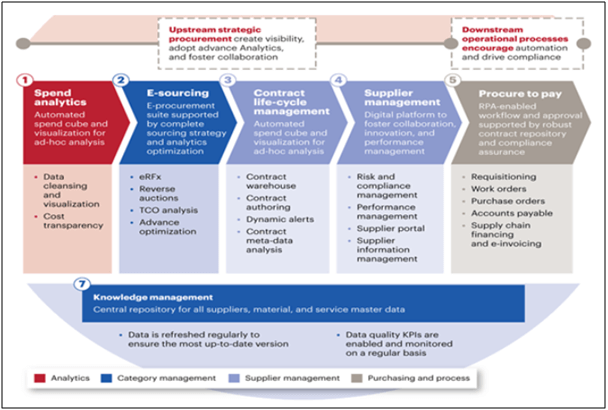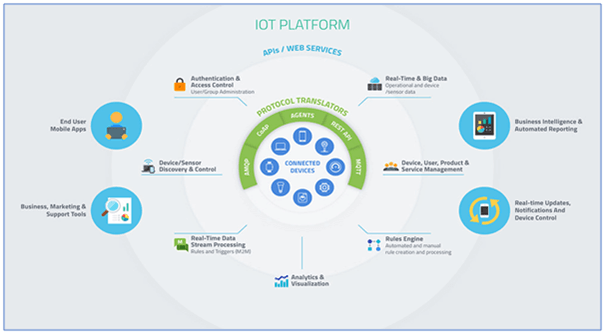Ship management procurement prospect has changed effectively. Since the early days of faxing over orders and waiting for vendors’ quotations, the internet has been a game-changer. With this, liaising between parties becomes much more efficient. Procurement costs can be substantial owing to the size of the business itself. Even a little change can show a significant difference in operating costs.
Table of Contents
Differentiating the Term of Procurement versus Purchasing
Purchasing is defined as the process of buying and accepting goods and services. Procurement, however, is defined as activities to obtain goods and services.Using the PP Organogram, the terminologies of Procurement vs Purchasing are best explained as shown in the diagram below.

Impacts of Digital Transformation
Leaders are aware that it imperatively aims attention on more than merely adopting technologies. A company must be arrayed, acquire the right mind-set for transformation, and have a clear vision of digitalization needs combining with a wide range of digital solutions and technologies segmented into two areas.
- Upstream strategic procurement – Own a profound understanding of spend and in volute supply market insights, interconnecting vendors’ networks, and relationship management. Digitalizing upstream procurement frames the spend visibility and transparency using high-ranking analytics to replenish sourcing strategies and optimizing business decisions.
- Downstream operational processes – Being much more transactional involves vast amounts of essential but repetitive tasks that require conformity and accuracy. These tasks use up a significant amount of time and resources. Digitalization should be concentrating on automating processes, ensuring compliance to improve productivity, and reducing mistakes. Ultimately lowering the cost to serve.

Digital Procurement in Three Main Areas
- Automation and Robotic Process Automation (RPA)
Automated and agile operations where Artificial Intelligence and robotic process automation (RPA) are changing a crucial range of procurement activities, including spend analysis and procure-to-pay cycle.
- Frictionless Collaboration
Collaboration platforms in real-time data collection, predicting analytics, these tools let procurement teams effectively share data and help cross-functional teams in growth solutions with suppliers and internal stakeholders. It quickens cycle times by improving coordination and supplier performances. Will lead in speed problem-solving.
- Smarter Procurement
This means having advanced classification management for sourcing strategies and improving forecasting. Wealthy data sets, optimization engines are tools to control demand and execute agreements. Reducing costs and spending better.
Digital Procurement Process
- Step 1 – Requisitioning
Procurement system is in place to process electronic goods and service requisitions. The functionality must be approachable to all individuals in the company authorized to make purchases.
- Step 2 – Approval Routing and Workflow
Procurement systems include workflow capabilities and the ability to set up automatic approval routing by good, service, dollar value.
- Step 3 – E-Purchase Orders
Improve electronic purchase order using procurement software via mobile devices.
- Step 4 – E-Receipts
Procurement system to automatically generate and deliver goods and services receipts upon delivery completed. The system needs to conform with barcode or RFID scanners to enable the automatic recognition of the delivered goods function.
- Step 5 – E-Invoicing
Procurement system to receive and process electronic invoices. There is an easy online creation for vendors who do not have a system that automatically generates electronic invoices through a supplier portal or document scanning.
- Step 6 – Automatic Reconciliation
A system that captures purchase orders, receipts, and invoices automatically must also be able to link and reconcile.
- Step 7 – E-Payment Options
Payment method of purchasing cards, electronics funds, electronic cheque and automatic cheque printing.
- Step 8 – Reclamation of Taxes
Procurement system will comprehend the relevant taxation codes and connecting into suitable tax tables to allow the buyer to correctly compute tax, reconcile taxes charged by suppliers, and define any exemptions the company is eligible for.
- Step 9 – Digital Analytics
An analysis is needed after the procurement cycle is done. There should be a noticeable reduction in cycle time.
Internet of Thing (IoT) Technology
The Internet of Things (IoT) is a network of connected devices and sensors. IoT helps procurement add collaboration, analytics, and engagement using various tools from sourcing and planning to contract negotiations, payment ,order delivery and supplier management.With its platform and custom professional services, myDevices, one of IoT solution company launch a IoT Platform as a Service as per the below figure, cause companies to take advantage of IoT with unique solutions to interact with customers and manage data.The IoT will do from the automated decisions made by interoperable devices receiving and acting on data derived from real-time interactions with the physical world.
Some benefits with IoT applications are as follows:
- Better visibility for products, services, processes, clients, partners vendors.
- Increased interfacing between humans and machines leads to better productivity, lower costs, improved accuracy, and fulfilling work experiences.
- Greater operational effectiveness, such as better asset utilization and longer uptimes, brought about by predictive analysis, forecasting, remote surveillance, and pre-emptive maintenance.

Cloud Computing Technology
Cloud computing is deployed by globally wide and small local companies, whereby hundreds or thousands of users, devices, and printers across locations and geographical divides relate to the Cloud’s data center. Via Cloud, it let the effective and organized platform that assists in keeping businesses costs under control.
In addition to high levels of approachability, cloud systems train a feeling of transparency among management and other team members. Individual personals can see their condition of requests in real-time through requisition processes and being informed of any changes instantly.

Procurement Processes in Cloud-Based Technology
- Purchase Requisitions
Visibility about purchase requests and instant updates cause to changes. Instant access to Product catalogs for purchase requests.
The full content is only visible to SIPMM members
Already a member? Please Login to continue reading.
References
Huang Qing Dian, GDPM. (2019). “Five Crucial Areas for Successful Transformation to Digital Procurement”. Retrieved from SIPMM: https://publication.sipmm.edu.sg/five-crucial-areas-successful-transformation-digital-procurement/,accessed 27/11/2020.
Joseph Meyer. (2019). “Blockchain & Procurement: A New Revolution?”. Retrieved from: https://medium.com/into-advanced-procurement/blockchain-procurement-a-new-revolution-22d0d9bcaede ,accessed 27/11/2020
Li Gui Li, ADPSM. (2020). “Five Digital Technologies for Procurement Optimization”. Retrieved from SIPMM: https://publication.sipmm.edu.sg/five-digital-technologies-procurement-optimization/,accessed 27/11/2020.
NLPA. (2019). “Sourcing Intelligence”. Retrieved from https://www.nextlevelpurchasing.com/news/purchasing-articles/sourcing-intelligence, accessed 27/11/2020.
Philip Charles Loges, ADPSM. (2019).“Crucial Digital Technologies for Effective Procurement”. Retrieved from SIPMM: https://publication.sipmm.edu.sg/crucial-digital-technologies-effective-procurement/,accessed 27/11/2020.
Sievo. (2019). “AI in Procurement”. Retrieved from https://sievo.com/resources/ai-in-procurement, accessed 27/11/2020.

